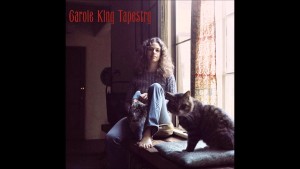Carole King Reflects on “Tapestry” Album (From Billboard Magazine)

Carole King on ‘Tapestry’ Album | Billboard 
Carole King Reflects on Her Classic, Chart-Topping 'Tapestry' Album
By Douglas Wolk

Carol King photographed in 1971.
Globe Photos/ZUMAPRESS
How an "absolutely sincere" easy-listening LP recorded amid Laurel Canyon's early-'70s hippie bliss remains one of the biggest-charting (and universally beloved) albums of all time, more than 40 years later.
Carole King's Tapestry made her a star in 1971, but before most of the album's devotees knew her name, she already had been an enormously successful songwriter for more than a decade. King and lyricist-husband Gerry Goffin spent most of the '60s writing hits like Little Eva's "The Loco-Motion" and The Monkees' "Pleasant Valley Sunday" (which reached No. 1 and No. 3 on the Billboard Hot 100, respectively). When the couple split, though, King moved from her New York hometown to Los Angeles' Laurel Canyon neighborhood, where she was drawn into the singer-songwriter scene associated with West Hollywood club the Troubadour.
The cover art for Tapestry, taken by famed rock photographer Jim McCrary, is an iconic vision of Southern Californian hippie bliss: King, barefoot and frizzy-haired, relaxing by her window with a crafts project and a cat. Neighbors who dropped by to record included Joni Mitchell and James Taylor. (Taylor's own version of Tapestry's "You've Got a Friend" became the second No. 1 single written by King in 1971 and won the performer his first Grammy.) "We were a community of people with a similar choice of career, similar influences, similar interests and a similar drive to have our music be heard by millions of people," recalls King, now 73. "An astonishing number of us achieved that."
Carole King on 'Tapestry' Album | Billboard
King had recorded a couple of minor hits in the early '60s, and the core of the Tapestry band had made two earlier albums, one of them under the name The City. But Tapestry was where her singular gifts blossomed. As Taylor tells Billboard, his longtime friend "decided to own her voice -- no gauze on the lens, no affected technique -- writing from her own personal experience and her own heart. She was herself, it read as being absolutely sincere, and it connected." King rarely had written words for her music before, but she came up with gorgeously plain-spoken lyrics about the difficulties and joys of grown-up love. "So Far Away," she notes, was inspired by missing her family -- the two daughters she had with Goffin, Louise and Sherry; and her second husband, bassist Charlie Larkey -- while on the road playing piano for Taylor in 1970.
Tapestry's first single, "It's Too Late"/"I Feel the Earth Move," spent five weeks atop the Hot 100 and featured words by another Laurel Canyon friend, lyricist Toni Stern. ("She always gave me a completed lyric that was so evocative on the page that the music practically wrote itself," says King.) And King's own reinterpretations of a pair of hits she and Goffin had written for other acts -- The Shirelles' "Will You Love Me Tomorrow" and Aretha Franklin's "(You Make Me Feel Like) A Natural Woman" -- transformed them into reports from the California front of the sexual revolution.
Tapestry was the kind of album in which listeners could hear their own lives reflected. "It might have been the Vietnam War, the violence, the cultural divide," says King. "People around the world have told me Tapestry helped them reconnect with basic human feelings when they really needed that." The LP spent 15 consecutive weeks at No. 1 on the Billboard 200 (the longest ever by a female solo artist at the time), 46 weeks in the top 10 and the better part of the '70s on the chart, yielding four Grammys and 10 million copies sold in the United States, according to the RIAA. It also became the cornerstone of King's career as a performer -- and, more recently, of her jukebox musical Beautiful. (She'll be feted at the Kennedy Center Honors in December.) "I had no idea how big Tapestry would be," says King. "One word sums up how I feel about that: gratitude."
Additional reporting by Frank DiGiacomo.
This story originally appeared in the November 21 issue of Billboard.


great stuff here! Thanks to your true appreciation for real music…